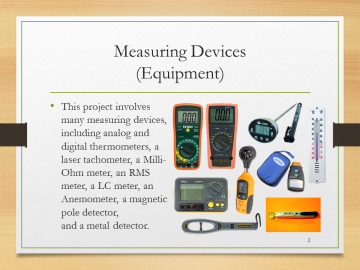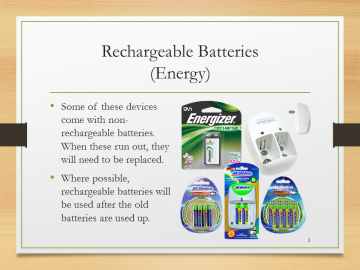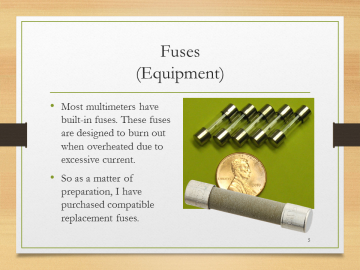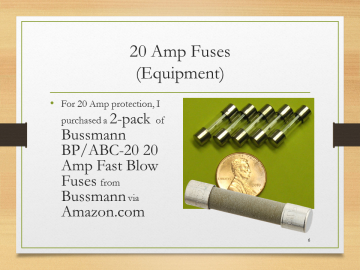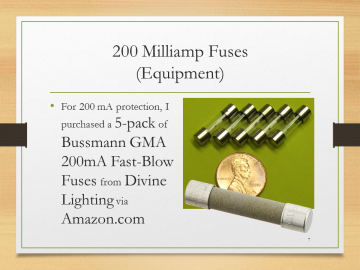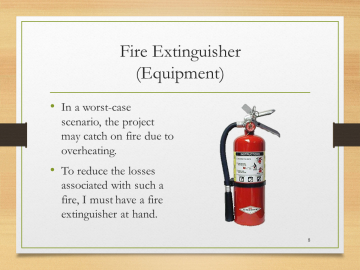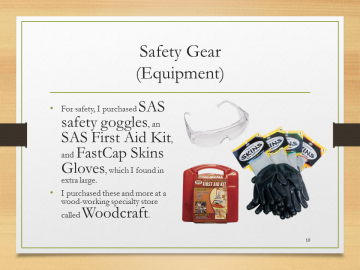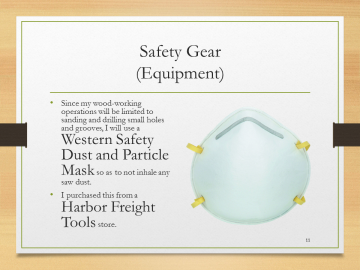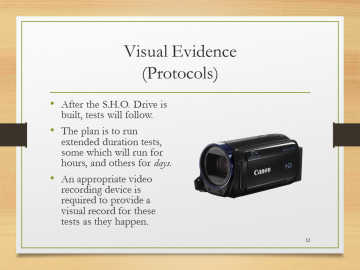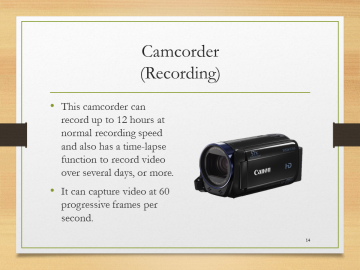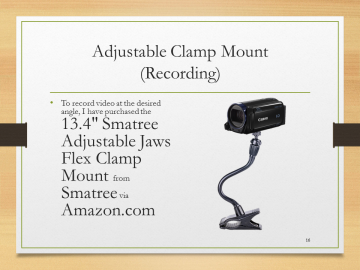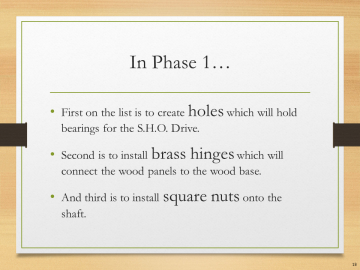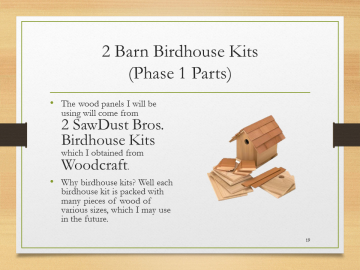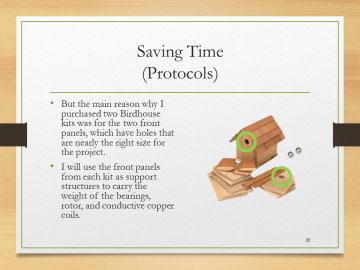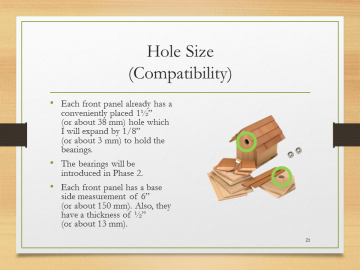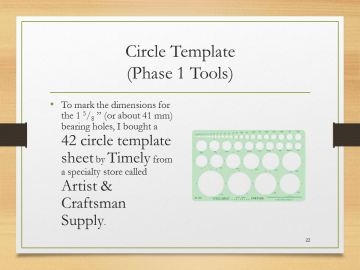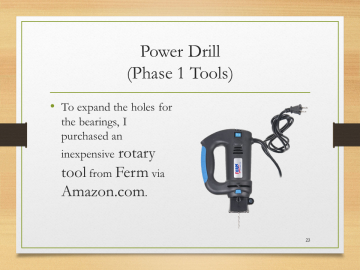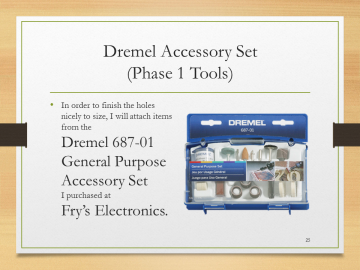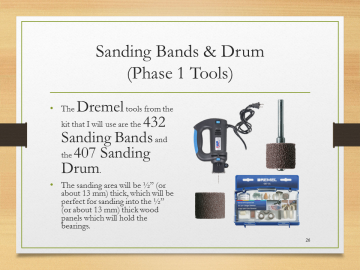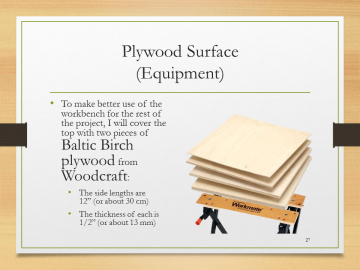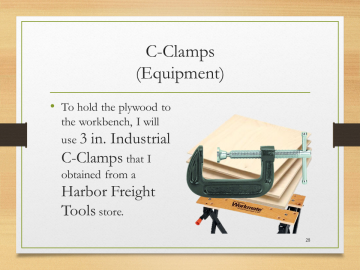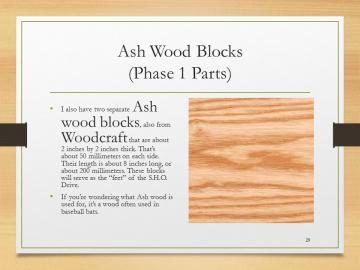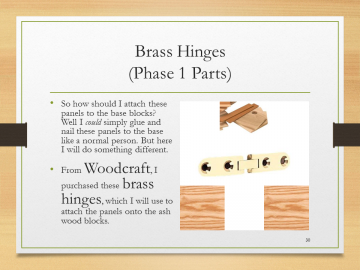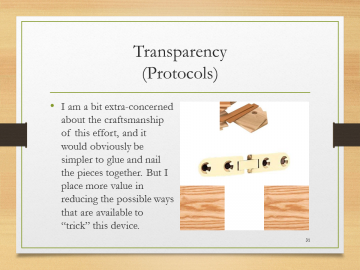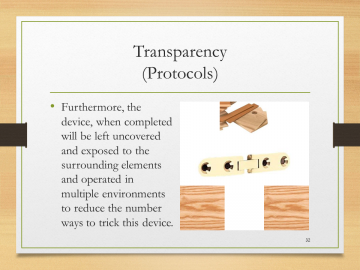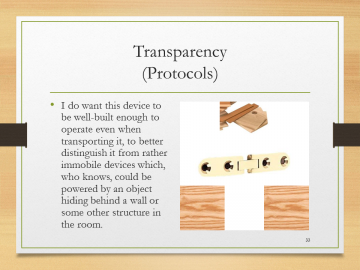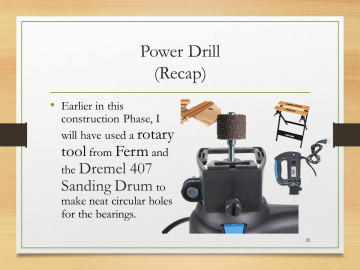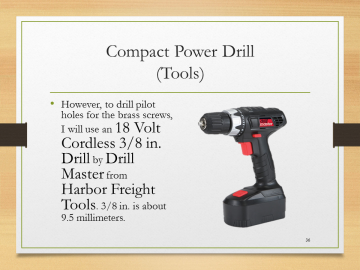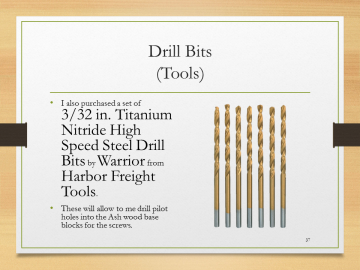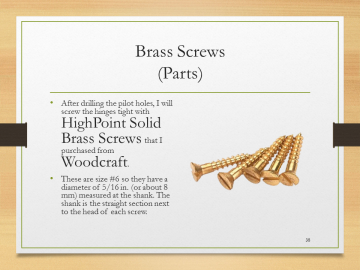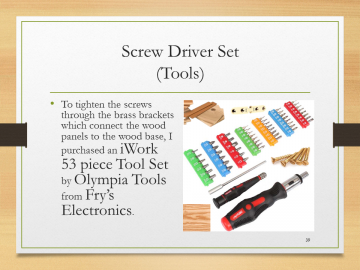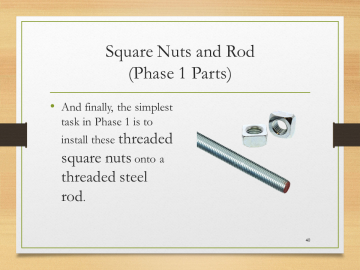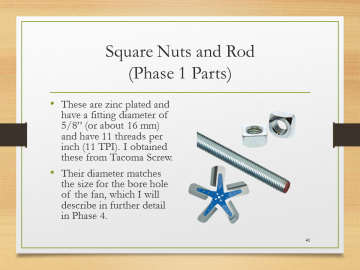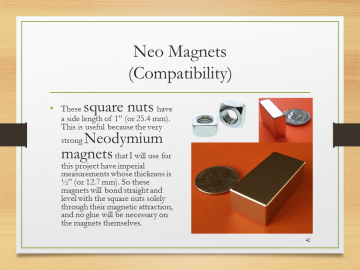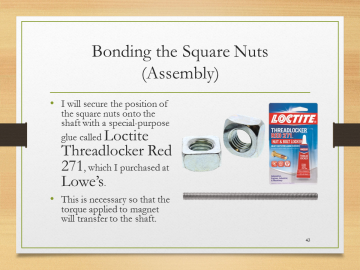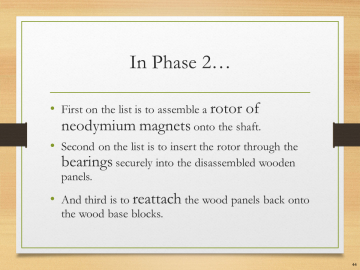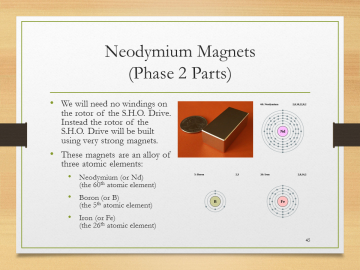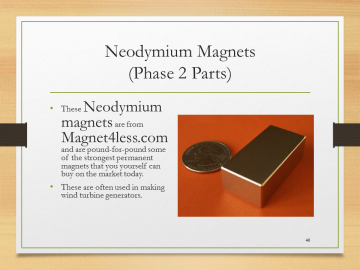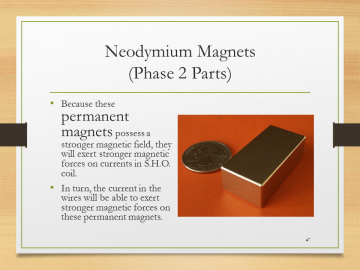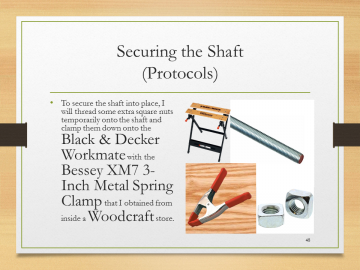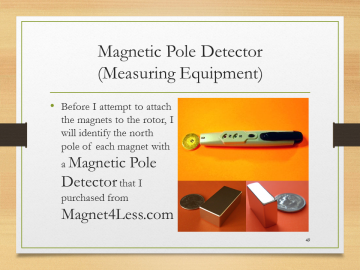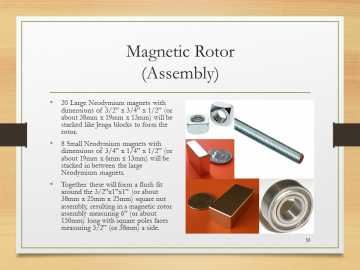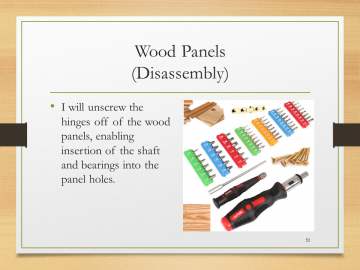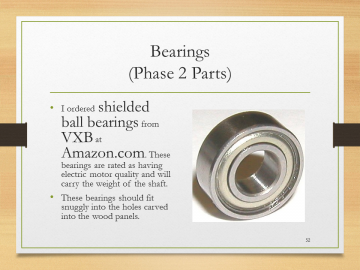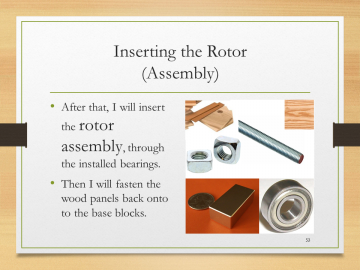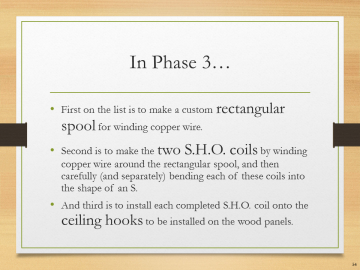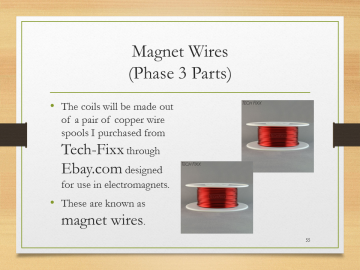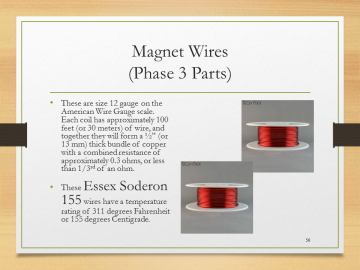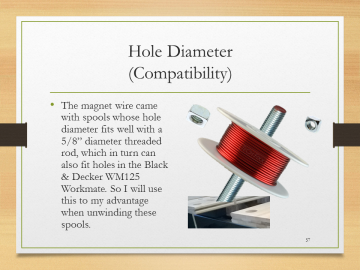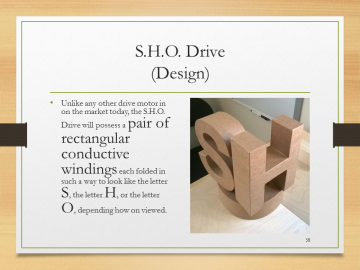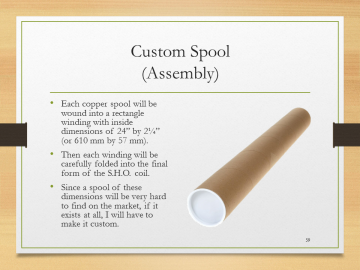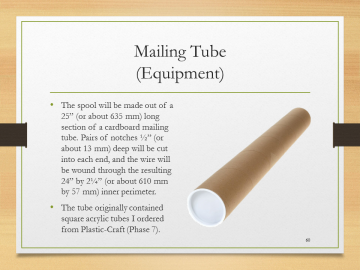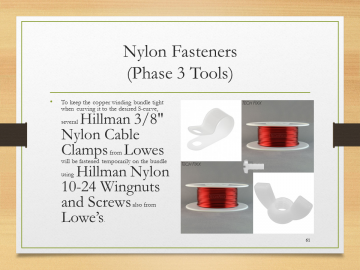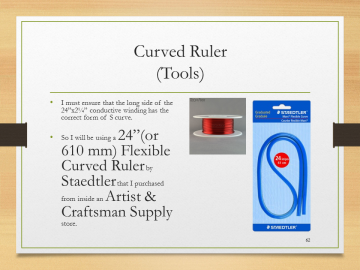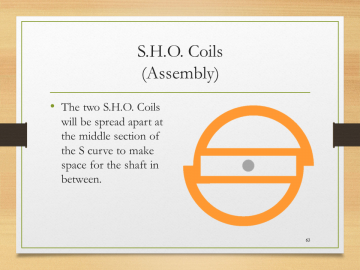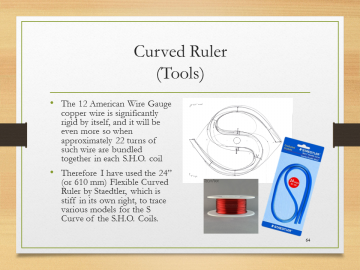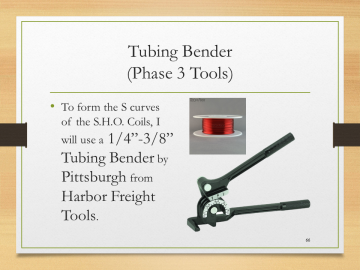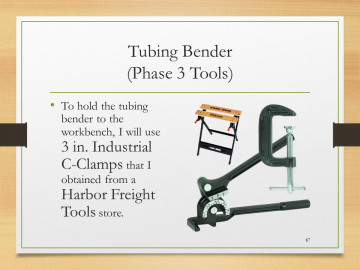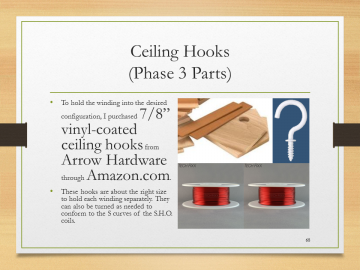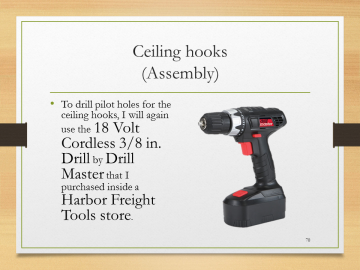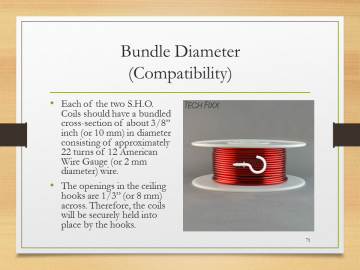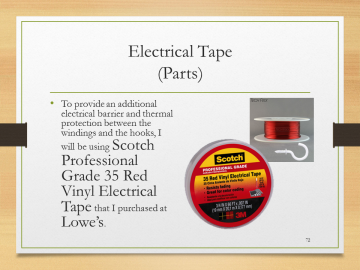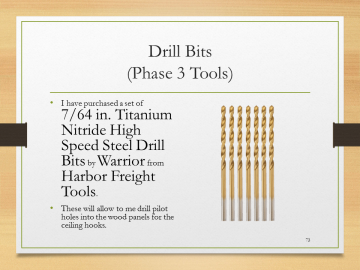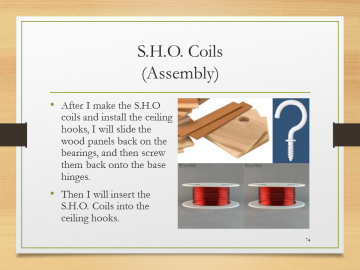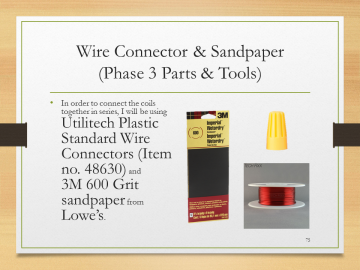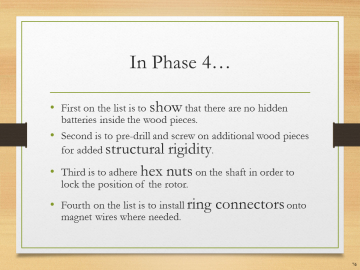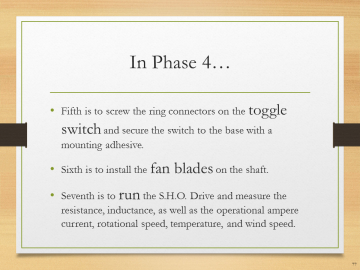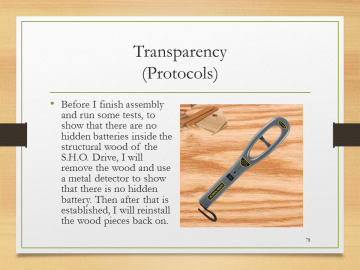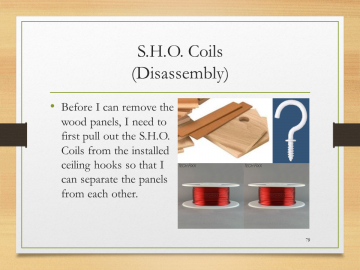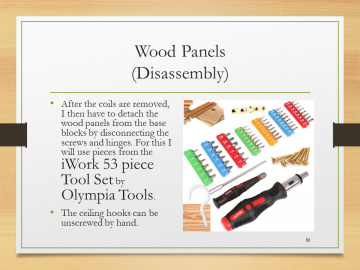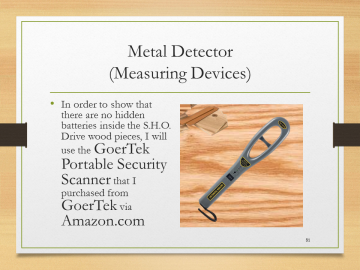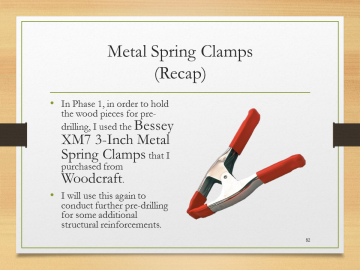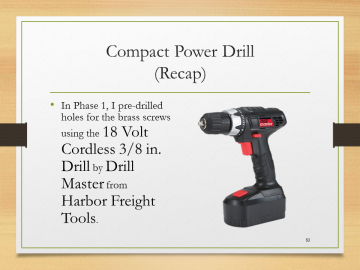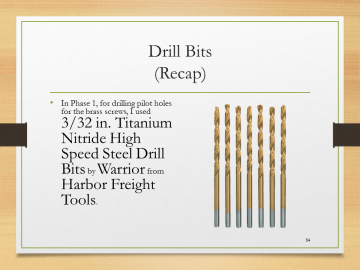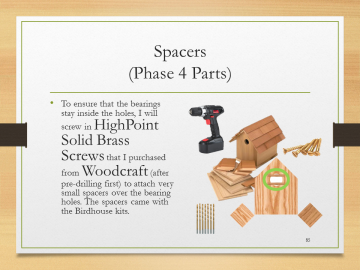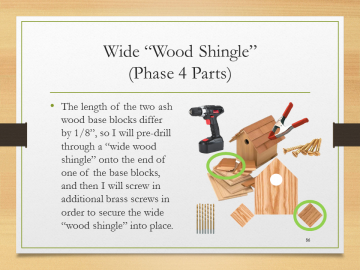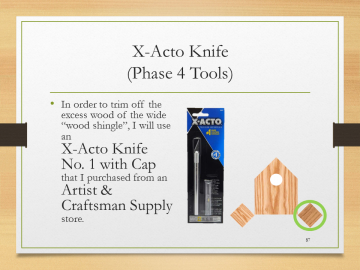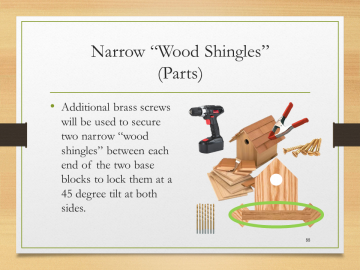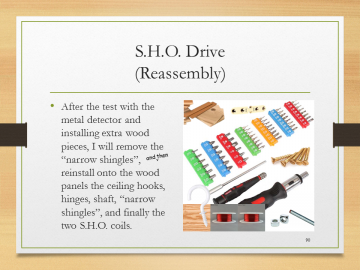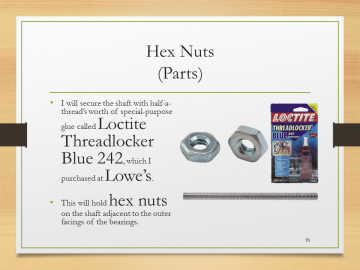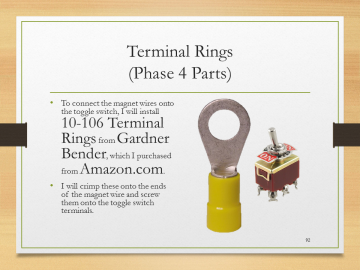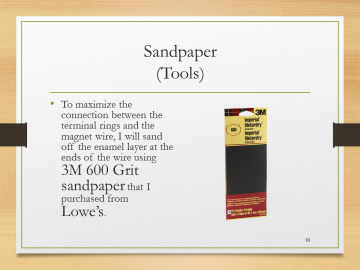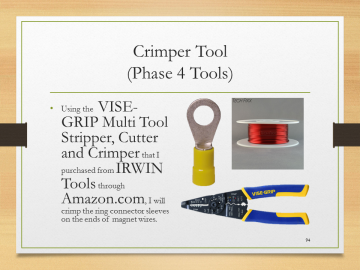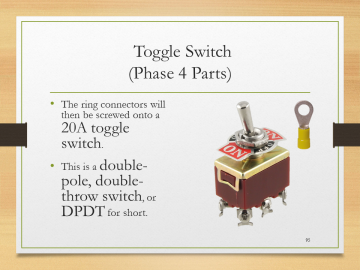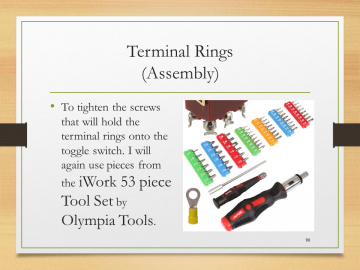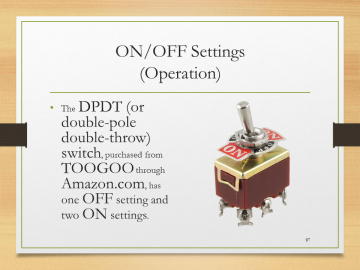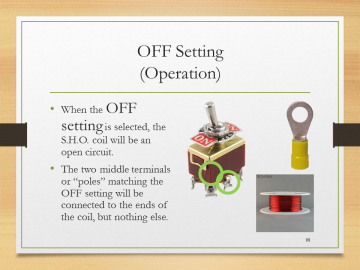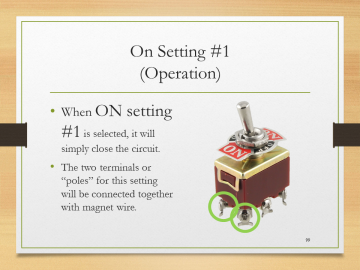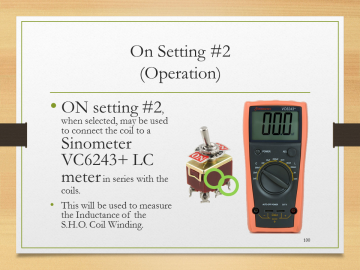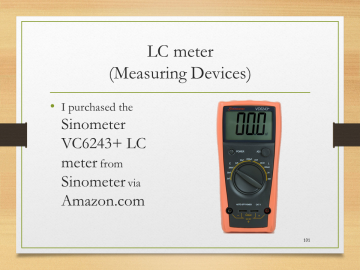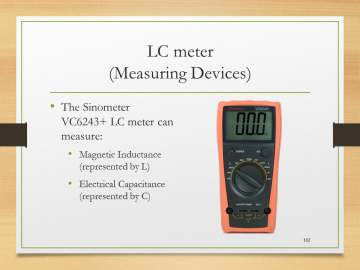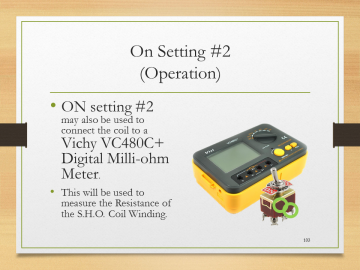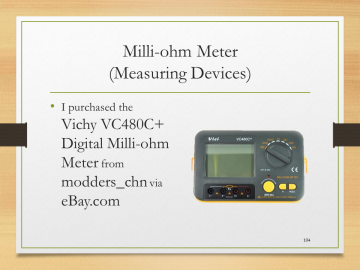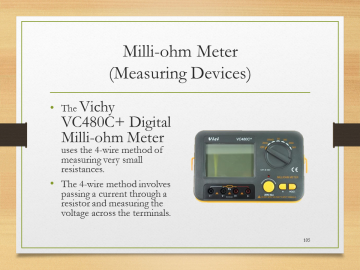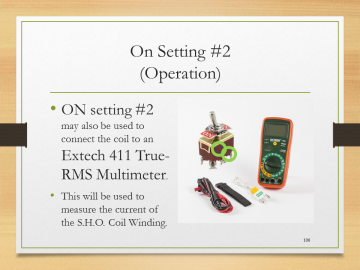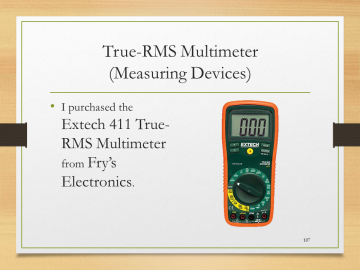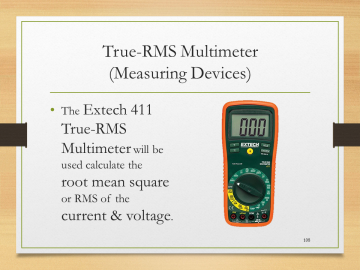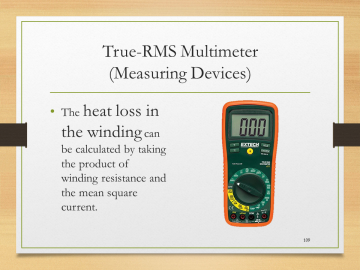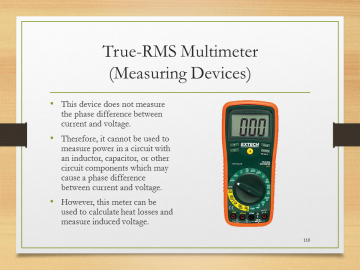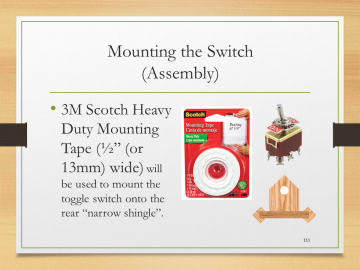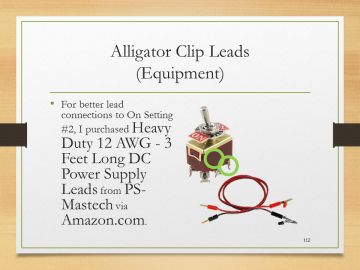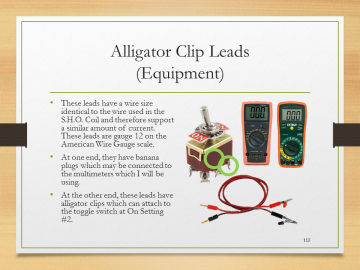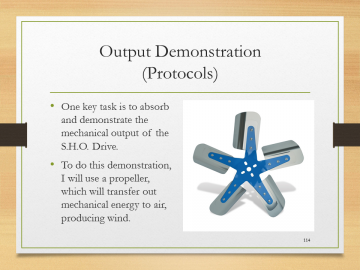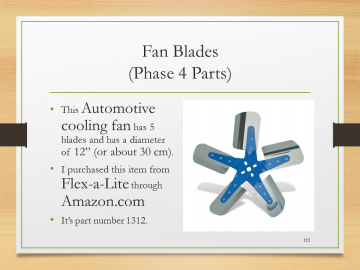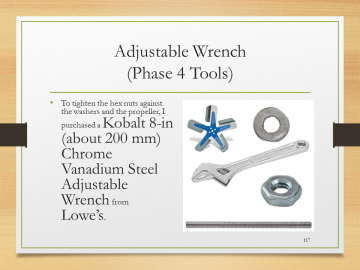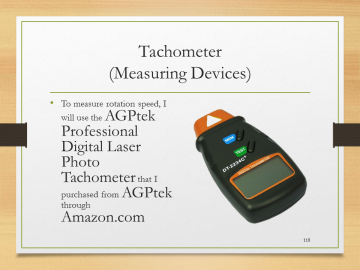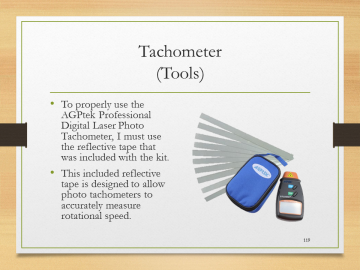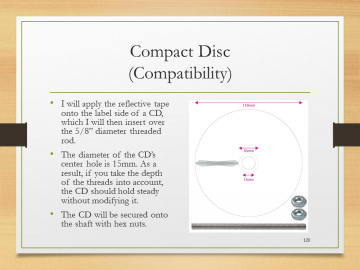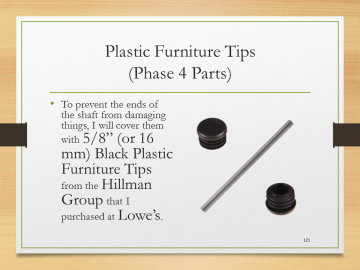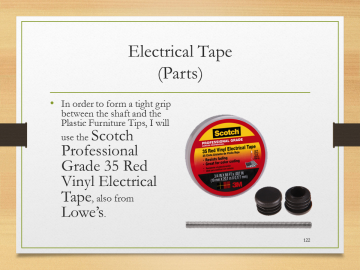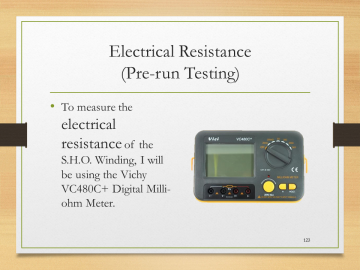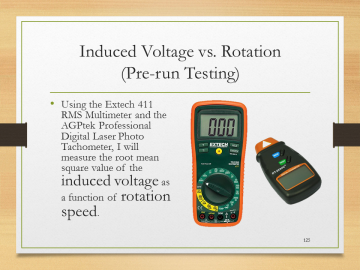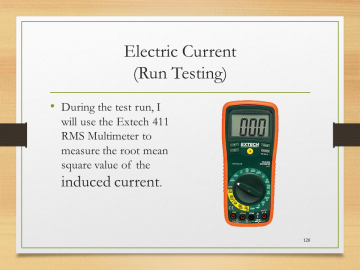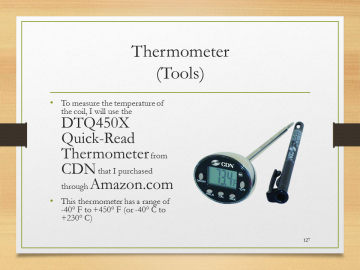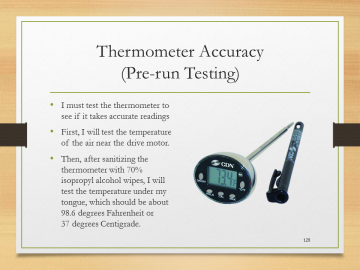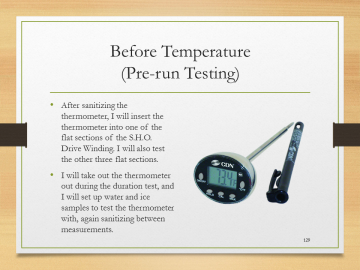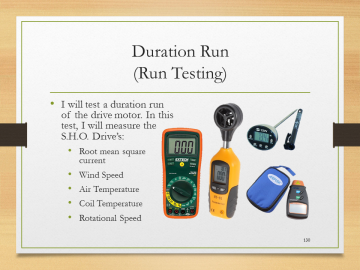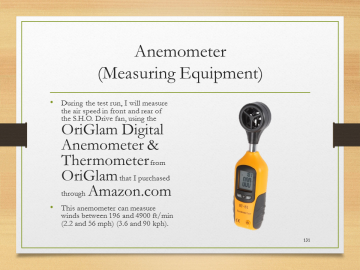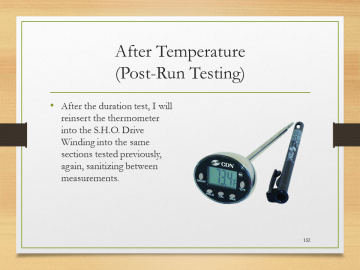|
|
| Line 115: |
Line 115: |
| | |lines=10 | | |lines=10 |
| | |footer= | | |footer= |
| | + | |Let's Build the S.H.O. Drive! - Slide 076 of 176.png||'''In Phase 4…'''<br>• First on the list is to show that there are no hidden batteries inside the wood pieces.<br>• Second is to pre-drill and screw on additional wood pieces for added structural rigidity.<br>• Third is to adhere hex nuts on the shaft in order to lock the position of the rotor.<br>• Fourth on the list is to install ring connectors onto magnet wires where needed. |
| | + | |Let's Build the S.H.O. Drive! - Slide 077 of 176.png||'''In Phase 4…'''<br>• Fifth is to screw the ring connectors on the toggle switch and secure the switch to the base with a mounting adhesive.<br>• Sixth is to install the fan blades on the shaft.<br>• Seventh is to run the S.H.O. Drive and measure the resistance, inductance, as well as the operational ampere current, rotational speed, temperature, and wind speed. |
| | + | |Let's Build the S.H.O. Drive! - Slide 078 of 176.png||'''Transparency'''<br>''(Protocols)''<br>• Before I finish assembly and run some tests, to show that there are no hidden batteries inside the structural wood of the S.H.O. Drive, I will remove the wood and use a metal detector to show that there is no hidden battery. Then after that is established, I will reinstall the wood pieces back on. |
| | + | |Let's Build the S.H.O. Drive! - Slide 079 of 176.png||'''S.H.O. Coils'''<br>''(Disassembly)''<br>• Before I can remove the wood panels, I need to first pull out the S.H.O. Coils from the installed ceiling hooks so that I can separate the panels from each other. |
| | + | |Let's Build the S.H.O. Drive! - Slide 080 of 176.png||'''Wood Panels'''<br>''(Disassembly)''<br>• After the coils are removed, I then have to detach the wood panels from the base blocks by disconnecting the screws and hinges. For this I will use pieces from the iWork 53 piece Tool Set by Olympia Tools.<br>• The ceiling hooks can be unscrewed by hand. |
| | + | |Let's Build the S.H.O. Drive! - Slide 081 of 176.png||'''Metal Detector'''<br>''(Measuring Devices)''<br>• In order to show that there are no hidden batteries inside the S.H.O. Drive wood pieces, I will use the GoerTek Portable Security Scanner that I purchased from GoerTek via Amazon.com |
| | + | |Let's Build the S.H.O. Drive! - Slide 082 of 176.png||'''Metal Spring Clamps'''<br>''(Recap)''<br>• In Phase 1, in order to hold the wood pieces for pre-drilling, I used the Bessey XM7 3-Inch Metal Spring Clamps that I purchased from Woodcraft.<br>• I will use this again to conduct further pre-drilling for some additional structural reinforcements. |
| | + | |Let's Build the S.H.O. Drive! - Slide 083 of 176.png||'''Compact Power Drill'''<br>''(Recap)''<br>• In Phase 1, I pre-drilled holes for the brass screws using the 18 Volt Cordless 3/8 in. Drill by Drill Master from Harbor Freight Tools. |
| | + | |Let's Build the S.H.O. Drive! - Slide 084 of 176.png||'''Drill Bits'''<br>''(Recap)''<br>• In Phase 1, for drilling pilot holes for the brass screws, I used 3/32 in. Titanium Nitride High Speed Steel Drill Bits by Warrior from Harbor Freight Tools. |
| | + | |Let's Build the S.H.O. Drive! - Slide 085 of 176.png||'''Spacers'''<br>''(Phase 4 Parts)''<br>• To ensure that the bearings stay inside the holes, I will screw in HighPoint Solid Brass Screws that I purchased from Woodcraft (after pre-drilling first) to attach very small spacers over the bearing holes. The spacers came with the Birdhouse kits. |
| | + | |Let's Build the S.H.O. Drive! - Slide 086 of 176.png||'''Wide “Wood Shingle”‘‘‘<br>''(Phase 4 Parts)''<br>• The length of the two ash wood base blocks differ by 1/8”, so I will pre-drill through a “wide wood shingle” onto the end of one of the base blocks, and then I will screw in additional brass screws in order to secure the wide “wood shingle” into place. |
| | + | |Let's Build the S.H.O. Drive! - Slide 087 of 176.png||'''X-Acto Knife'''<br>''(Phase 4 Tools)''<br>• In order to trim off the excess wood of the wide “wood shingle”, I will use an X-Acto Knife No. 1 with Cap that I purchased from an Artist & Craftsman Supply store. |
| | + | |Let's Build the S.H.O. Drive! - Slide 088 of 176.png||'''Narrow “Wood Shingles”‘‘‘<br>''(Parts)''<br>• Additional brass screws will be used to secure two narrow “wood shingles” between each end of the two base blocks to lock them at a 45 degree tilt at both sides. |
| | + | |Let's Build the S.H.O. Drive! - Slide 089 of 176.png||#ShoDrives @ShoDrives Sho.wiki Drive Replication and Collaboration Site YouTube.com/c/ShoWiki Watch and Subscribe Site Facebook.com/ShoDrives Like, Share, and Fan Site |
| | + | |Let's Build the S.H.O. Drive! - Slide 090 of 176.png||'''S.H.O. Drive'''<br>''(Reassembly)''<br>• After the test with the metal detector and installing extra wood pieces, I will remove the “narrow shingles”, reinstall onto the wood panels the ceiling hooks, hinges, shaft, “narrow shingles”, and finally the two S.H.O. coils. |
| | + | |Let's Build the S.H.O. Drive! - Slide 091 of 176.png||'''Hex Nuts'''<br>''(Parts)''<br>• I will secure the shaft with half-a-thread’s worth of special-purpose glue called Loctite Threadlocker Blue 242, which I purchased at Lowe’s.<br>• This will hold hex nuts on the shaft adjacent to the outer facings of the bearings. |
| | + | |Let's Build the S.H.O. Drive! - Slide 092 of 176.png||'''Terminal Rings'''<br>''(Phase 4 Parts)''<br>• To connect the magnet wires onto the toggle switch, I will install 10-106 Terminal Rings from Gardner Bender, which I purchased from Amazon.com.<br>• I will crimp these onto the ends of the magnet wire and screw them onto the toggle switch terminals. |
| | + | |Let's Build the S.H.O. Drive! - Slide 093 of 176.png||'''Sandpaper'''<br>''(Tools)''<br>• To maximize the connection between the terminal rings and the magnet wire, I will sand off the enamel layer at the ends of the wire using 3M 600 Grit sandpaper that I purchased from Lowe’s. |
| | + | |Let's Build the S.H.O. Drive! - Slide 094 of 176.png||'''Crimper Tool'''<br>''(Phase 4 Tools)''<br>• Using the VISE-GRIP Multi Tool Stripper, Cutter and Crimper that I purchased from IRWIN Tools through Amazon.com, I will crimp the ring connector sleeves on the ends of magnet wires. |
| | + | |Let's Build the S.H.O. Drive! - Slide 095 of 176.png||''' Toggle Switch'''<br>''(Phase 4 Parts)''<br>• The ring connectors will then be screwed onto a 20A toggle switch.<br>• This is a double-pole, double-throw switch, or DPDT for short. |
| | + | |Let's Build the S.H.O. Drive! - Slide 096 of 176.png||'''Terminal Rings'''<br>''(Assembly)''<br>• To tighten the screws that will hold the terminal rings onto the toggle switch. I will again use pieces from the iWork 53 piece Tool Set by Olympia Tools. |
| | + | |Let's Build the S.H.O. Drive! - Slide 097 of 176.png||'''ON/OFF Settings'''<br>''(Operation)''<br>• The DPDT (or double-pole double-throw) switch, purchased from TOOGOO through Amazon.com, has one OFF setting and two ON settings. |
| | + | |Let's Build the S.H.O. Drive! - Slide 098 of 176.png||'''OFF Setting'''<br>''(Operation)''<br>• When the OFF setting is selected, the S.H.O. coil will be an open circuit.<br>• The two middle terminals or “poles” matching the OFF setting will be connected to the ends of the coil, but nothing else. |
| | + | |Let's Build the S.H.O. Drive! - Slide 099 of 176.png||'''On Setting #1'''<br>''(Operation)''<br>• When ON setting #1 is selected, it will simply close the circuit.<br>• The two terminals or “poles” for this setting will be connected together with magnet wire. |
| | + | |Let's Build the S.H.O. Drive! - Slide 100 of 176.png||'''On Setting #2'''<br>''(Operation)''<br>• ON setting #2, when selected, may be used to connect the coil to a Sinometer VC6243+ LC meter in series with the coils.<br>• This will be used to measure the Inductance of the S.H.O. Coil Winding. |
| | + | |Let's Build the S.H.O. Drive! - Slide 101 of 176.png||'''LC meter'''<br>''(Measuring Devices)''<br>• I purchased the Sinometer VC6243+ LC meter from Sinometer via Amazon.com |
| | + | |Let's Build the S.H.O. Drive! - Slide 102 of 176.png||'''LC meter'''<br>''(Measuring Devices)''<br>• The Sinometer VC6243+ LC meter can measure:<br>• Magnetic Inductance <br>''(represented by L)''<br>• Electrical Capacitance <br>''(represented by C) |
| | + | |Let's Build the S.H.O. Drive! - Slide 103 of 176.png||'''On Setting #2'''<br>''(Operation)''<br>• ON setting #2 may also be used to connect the coil to a Vichy VC480C+ Digital Milli-ohm Meter.<br>• This will be used to measure the Resistance of the S.H.O. Coil Winding. |
| | + | |Let's Build the S.H.O. Drive! - Slide 104 of 176.png||'''Milli-ohm Meter'''<br>''(Measuring Devices)''<br>• I purchased the Vichy VC480C+ Digital Milli-ohm Meter from modders_chn via eBay.com |
| | + | |Let's Build the S.H.O. Drive! - Slide 105 of 176.png||'''Milli-ohm Meter'''<br>''(Measuring Devices)''<br>• The Vichy VC480C+ Digital Milli-ohm Meter uses the 4-wire method of measuring very small resistances.<br>• The 4-wire method involves passing a current through a resistor and measuring the voltage across the terminals. |
| | + | |Let's Build the S.H.O. Drive! - Slide 106 of 176.png||'''On Setting #2'''<br>''(Operation)''<br>• ON setting #2 may also be used to connect the coil to an Extech 411 True-RMS Multimeter.<br>• This will be used to measure the current of the S.H.O. Coil Winding. |
| | + | |Let's Build the S.H.O. Drive! - Slide 107 of 176.png||'''True-RMS Multimeter'''<br>''(Measuring Devices)''<br>• I purchased the Extech 411 True-RMS Multimeter from Fry’s Electronics. |
| | + | |Let's Build the S.H.O. Drive! - Slide 108 of 176.png||'''True-RMS Multimeter'''<br>''(Measuring Devices)''<br>• The Extech 411 True-RMS Multimeter will be used calculate the root mean square or RMS of the current & voltage. |
| | + | |Let's Build the S.H.O. Drive! - Slide 109 of 176.png||'''True-RMS Multimeter'''<br>''(Measuring Devices)''<br>• The heat loss in the winding can be calculated by taking the product of winding resistance and the mean square current. |
| | + | |Let's Build the S.H.O. Drive! - Slide 110 of 176.png||'''True-RMS Multimeter'''<br>''(Measuring Devices)''<br>• This device does not measure the phase difference between current and voltage.<br>• Therefore, it cannot be used to measure power in a circuit with an inductor, capacitor, or other circuit components which may cause a phase difference between current and voltage.<br>• However, this meter can be used to calculate heat losses and measure induced voltage. |
| | + | |Let's Build the S.H.O. Drive! - Slide 111 of 176.png||'''Mounting the Switch'''<br>''(Assembly)''<br>• 3M Scotch Heavy Duty Mounting Tape (½” (or 13mm) wide) will be used to mount the toggle switch onto the rear “narrow shingle”. |
| | + | |Let's Build the S.H.O. Drive! - Slide 112 of 176.png||'''Alligator Clip Leads'''<br>''(Equipment)''<br>• For better lead connections to On Setting #2, I purchased Heavy Duty 12 AWG - 3 Feet Long DC Power Supply Leads from PS-Mastech via Amazon.com. |
| | + | |Let's Build the S.H.O. Drive! - Slide 113 of 176.png||'''Alligator Clip Leads'''<br>''(Equipment)''<br>• These leads have a wire size identical to the wire used in the S.H.O. Coil and therefore support a similar amount of current. These leads are gauge 12 on the American Wire Gauge scale.<br>• At one end, they have banana plugs which may be connected to the multimeters which I will be using.<br>• At the other end, these leads have alligator clips which can attach to the toggle switch at On Setting #2. |
| | + | |Let's Build the S.H.O. Drive! - Slide 114 of 176.png||'''Output Demonstration'''<br>''(Protocols)''<br>• One key task is to absorb and demonstrate the mechanical output of the S.H.O. Drive.<br>• To do this demonstration, I will use a propeller, which will transfer out mechanical energy to air, producing wind. |
| | + | |Let's Build the S.H.O. Drive! - Slide 115 of 176.png||'''Fan Blades'''<br>''(Phase 4 Parts)''<br>• This Automotive cooling fan has 5 blades and has a diameter of 12” (or about 30 cm).<br>• I purchased this item from Flex-a-Lite through Amazon.com <br>• It’s part number 1312. |
| | + | |Let's Build the S.H.O. Drive! - Slide 116 of 176.png||'''Washers and Hex Nuts'''<br>''(Parts)''<br>• I will secure the 12” (or 30 cm) diameter fan with its 5/8” (or 16 mm) bore hole, through the 5/8” (or 16 mm) diameter rod by compressing it between a pair of zinc-plated washers that I purchased at Lowe’s and a pair of zinc-plated hex nuts that I purchased at Tacoma Screw. |
| | + | |Let's Build the S.H.O. Drive! - Slide 117 of 176.png||'''Adjustable Wrench'''<br>''(Phase 4 Tools)''<br>• To tighten the hex nuts against the washers and the propeller, I purchased a Kobalt 8-in (about 200 mm) Chrome Vanadium Steel Adjustable Wrench from Lowe’s. |
| | + | |Let's Build the S.H.O. Drive! - Slide 118 of 176.png||'''Tachometer'''<br>''(Measuring Devices)''<br>• To measure rotation speed, I will use the AGPtek Professional Digital Laser Photo Tachometer that I purchased from AGPtek through Amazon.com |
| | + | |Let's Build the S.H.O. Drive! - Slide 119 of 176.png||'''Tachometer'''<br>''(Tools)''<br>• To properly use the AGPtek Professional Digital Laser Photo Tachometer, I must use the reflective tape that was included with the kit.<br>• This included reflective tape is designed to allow photo tachometers to accurately measure rotational speed. |
| | + | |Let's Build the S.H.O. Drive! - Slide 120 of 176.png||'''Compact Disc'''<br>''(Compatibility)''<br>• I will apply the reflective tape onto the label side of a CD, which I will then insert over the 5/8” diameter threaded rod.<br>• The diameter of the CD’s center hole is 15mm. As a result, if you take the depth of the threads into account, the CD should hold steady without modifying it.<br>• The CD will be secured onto the shaft with hex nuts. |
| | + | |Let's Build the S.H.O. Drive! - Slide 121 of 176.png||'''Plastic Furniture Tips'''<br>''(Phase 4 Parts)''<br>• To prevent the ends of the shaft from damaging things, I will cover them with 5/8” (or 16 mm) Black Plastic Furniture Tips from the Hillman Group that I purchased at Lowe’s. |
| | + | |Let's Build the S.H.O. Drive! - Slide 122 of 176.png||'''Electrical Tape'''<br>''(Parts)''<br>• In order to form a tight grip between the shaft and the Plastic Furniture Tips, I will use the Scotch Professional Grade 35 Red Vinyl Electrical Tape, also from Lowe’s. |
| | + | |Let's Build the S.H.O. Drive! - Slide 123 of 176.png||'''Electrical Resistance'''<br>''(Pre-run Testing)''<br>• To measure the electrical resistance of the S.H.O. Winding, I will be using the Vichy VC480C+ Digital Milli-ohm Meter. |
| | + | |Let's Build the S.H.O. Drive! - Slide 124 of 176.png||'''Magnetic Inductance'''<br>''(Pre-run Testing)''<br>• To measure the magnetic inductance of the S.H.O. Winding as a function of rotor position, I will use the Sinometer VC6243+ LC meter. |
| | + | |Let's Build the S.H.O. Drive! - Slide 125 of 176.png||'''Induced Voltage vs. Rotation'''<br>''(Pre-run Testing)''<br>• Using the Extech 411 RMS Multimeter and the AGPtek Professional Digital Laser Photo Tachometer, I will measure the root mean square value of the induced voltage as a function of rotation speed. |
| | + | |Let's Build the S.H.O. Drive! - Slide 126 of 176.png||'''Electric Current'''<br>''(Run Testing)''<br>• During the test run, I will use the Extech 411 RMS Multimeter to measure the root mean square value of the induced current. |
| | + | |Let's Build the S.H.O. Drive! - Slide 127 of 176.png||'''Thermometer'''<br>''(Tools)''<br>• To measure the temperature of the coil, I will use the DTQ450X Quick-Read Thermometer from CDN that I purchased through Amazon.com<br>• This thermometer has a range of -40° F to +450° F (or -40° C to +230° C) |
| | + | |Let's Build the S.H.O. Drive! - Slide 128 of 176.png||'''Thermometer Accuracy'''<br>''(Pre-run Testing)''<br>• I must test the thermometer to see if it takes accurate readings<br>• First, I will test the temperature of the air near the drive motor.<br>• Then, after sanitizing the thermometer with 70% isopropyl alcohol wipes, I will test the temperature under my tongue, which should be about 98.6 degrees Fahrenheit or 37 degrees Centigrade. |
| | + | |Let's Build the S.H.O. Drive! - Slide 129 of 176.png||'''Before Temperature'''<br>''(Pre-run Testing)''<br>• After sanitizing the thermometer, I will insert the thermometer into one of the flat sections of the S.H.O. Drive Winding. I will also test the other three flat sections.<br>• I will take out the thermometer out during the duration test, and I will set up water and ice samples to test the thermometer with, again sanitizing between measurements. |
| | + | |Let's Build the S.H.O. Drive! - Slide 130 of 176.png||'''Duration Run'''<br>''(Run Testing)''<br>• I will test a duration run of the drive motor. In this test, I will measure the S.H.O. Drive’s:<br>• Root mean square current<br>• Wind Speed<br>• Air Temperature<br>• Coil Temperature<br>• Rotational Speed |
| | + | |Let's Build the S.H.O. Drive! - Slide 131 of 176.png||'''Anemometer'''<br>''(Measuring Equipment)''<br>• During the test run, I will measure the air speed in front and rear of the S.H.O. Drive fan, using the OriGlam Digital Anemometer & Thermometer from OriGlam that I purchased through Amazon.com<br>• This anemometer can measure winds between 196 and 4900 ft/min <br>''(2.2 and 56 mph) (3.6 and 90 kph). |
| | + | |Let's Build the S.H.O. Drive! - Slide 132 of 176.png||'''After Temperature'''<br>''(Post-Run Testing)''<br>• After the duration test, I will reinsert the thermometer into the S.H.O. Drive Winding into the same sections tested previously, again, sanitizing between measurements. |
| | }} | | }} |
| | <div style="clear:both"></div> | | <div style="clear:both"></div> |

